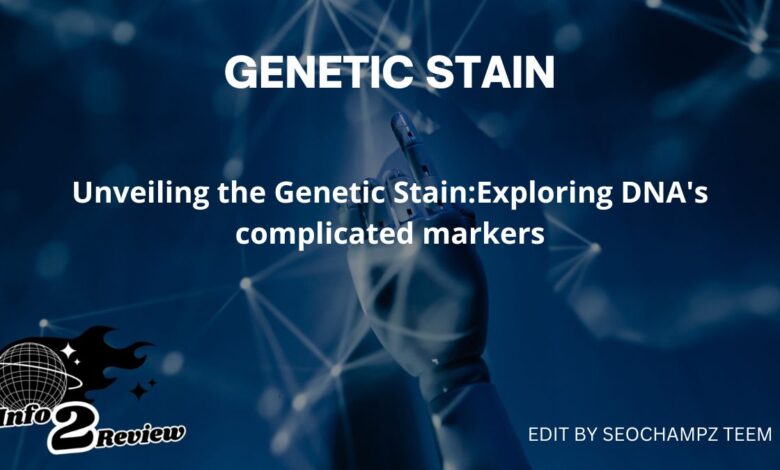Unveiling the Genetic Stain:Exploring DNA’s complicated markers

Understanding the genetics of stains can provide valuable insights into how they form and how best to tackle them effectively. In this comprehensive guide, we will delve into the science behind stains, including their genetic composition, factors that influence stain formation, and strategies for successful stain removal.
The Genetic Makeup of Stains:
To understand the genetics of stains, it is crucial to examine their basic composition. Stains are essentially foreign substances that have adhered to a surface, such as fabric or carpet fibres. These substances can vary widely in their chemical composition and physical properties, leading to a diverse range of stains encountered in daily life.
The genetic makeup of a stain can be influenced by various factors, including its source and the type of material it has stained. For example, a wine stain contains pigments from the grapes used to make the wine, while a grease stain may consist of fatty acids and other components found in cooking oils. Understanding the specific genetic components of a stain can help in choosing the most effective cleaning agents and techniques for removal.
Factors Influencing Stain Formation:
Several factors can influence the formation of stains, including the nature of the staining substance, the porosity of the surface being stained, and environmental conditions like temperature and humidity. Additionally, individual genetic factors can play a role in how easily a person’s clothing or fabrics become stained.
Genetics can impact the composition of sweat and oil produced by the skin, which can contribute to staining on clothing and other surfaces. Certain genetic variations may also affect the way fabrics interact with different staining substances, making some materials more prone to staining than others.
Furthermore, genetic predispositions to certain medical conditions or dietary habits can influence the likelihood of encountering specific types of stains. For example, individuals with genetic mutations that affect the metabolism of certain foods may be more prone to food stains on their clothing.
Related post
The Rising Star: Helena Danae and Her Journey to Success
Eric Weinberger’s Wife: A Journey of Love and Support
Strategies for Successful Stain Removal:
Effective stain removal requires a combination of the right tools, techniques, and genetic knowledge of the stain in question. Here are some strategies for successful stain removal based on the genetics of stains:
1. Identify the Stain: Before attempting to remove a stain, it is essential to identify its source and genetic composition. Different types of stains require different treatment methods, so knowing what you are dealing with is crucial.
2. Choose the Right Cleaning Agent: Once you have identified the stain, select a cleaning agent that targets the specific genetic components of the stain. For example, enzymatic cleaners are effective for protein-based stains like blood or urine, while solvent-based cleaners work well on oil and grease stains.
3. Test in an Inconspicuous Area: Before applying the cleaning agent to the stained area, test it in a hidden spot to ensure that it does not cause damage or discoloration to the fabric or surface.
4. Follow Proper Techniques: When treating a stain, follow the recommended techniques for application and removal of the cleaning agent. Scrubbing too vigorously or using excessive heat can damage the fabric and make the stain more difficult to remove.
5. Repeat if Necessary: Some stains may require multiple treatments to fully remove them. If the stain persists after the initial cleaning, repeat the process until the stain is gone.
6. Launder or Rinse: After treating the stain, launder clothing items according to the manufacturer’s instructions or rinse the stained area with clean water to remove any remaining residue from the cleaning agent.
7. Seek Professional Help: If you are unsure about how to remove a particular stain or if attempts at removal have been unsuccessful, consider seeking professional help from a dry cleaner or cleaning service.
In conclusion, understanding the genetics of stains can provide valuable insights into how stains form, what factors influence their composition, and how best to remove them effectively. By applying the strategies outlined in this guide, you can tackle stains with confidence and keep your fabrics and surfaces looking clean and fresh. Remember that patience and persistence are key when dealing with stubborn stains, and don’t hesitate to seek assistance if needed.
FAQS
1.Are certain individuals more prone to getting stains than others due to their genetics?
Yes, genetics can play a role in an individual’s propensity to get stains. Factors such as variations in sweat composition, skin oil production, and metabolism can influence how easily stains form on clothing and other surfaces.
2.Can genetic factors affect the colour or intensity of a stain?
Yes, the genetic components of a staining substance can impact the colour and intensity of a stain. For example, pigments from different foods or beverages can create stains of varying colours, while the concentration of certain chemicals can influence how deeply a stain penetrates a surface.
3. Do genetic variations influence the effectiveness of stain removal methods?
Genetic variations can indeed affect the effectiveness of stain removal methods. For instance, individuals with sensitivities to certain cleaning agents or materials may need to be cautious when selecting stain removal products. Additionally, genetic factors can influence the porosity and texture of fabrics, which can impact how well stains respond to cleaning treatments.
4.Can DNA analysis be used to identify the source of a stain?
DNA analysis can potentially be used to identify the genetic origin of a stain, particularly in forensic or investigative settings. By analysing the genetic material present in a stain, experts may be able to determine the source of the stain, such as the species or individual it came from.
5.Are there genetic tests available to determine an individual’s predisposition to certain types of stains?
While there are no specific genetic tests designed to predict an individual’s predisposition to stains, research into the genetic factors influencing stain formation and removal continues to advance. In the future, personalised genetic testing may offer insights into how an individual’s genetic makeup influences their interactions with staining substances.
Follow us on Google news for more exciting articles.




